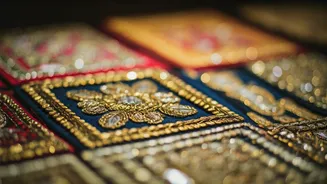Jadau: Artistry Revealed
Jadau, an ancient jewelry-making technique, involves setting precious stones within a gold framework. This intricate process, brought to India by the Mughals,
results in stunning pieces showcasing vibrant colors and elaborate designs. The stones are meticulously placed without any use of adhesives, instead utilizing the gold itself to secure the gems. The value of Jadau jewelry comes not only from its precious materials but also from the skill and artistry of the craftsmen. This is because creating Jadau jewelry requires a high degree of skill and precision. The final outcome is always unique.
Polki: Uncut Diamonds
Polki jewelry features uncut diamonds, which retain their natural brilliance and raw beauty. Unlike other diamonds that are faceted, Polki stones are used in their original, unpolished form. This gives them a distinct look. Popular in Indian weddings, Polki jewelry is often set in gold or other precious metals, creating a luxurious and traditional aesthetic. The use of uncut diamonds has been a prominent feature in Indian jewelry for centuries. This enduring popularity stems from their radiant appearance.
Kundan: Setting the Scene
Kundan jewelry involves setting gemstones, typically using a gold foil between the stones and their base. This method is often combined with Jadau, creating elaborate designs. Skilled artisans use heated gold foil to secure the gemstones. The technique produces smooth surfaces and a striking shine. Kundan jewelry, originating in Rajasthan and Gujarat, is a testament to India's rich jewelry heritage. This type of jewelry has always been a symbol of luxury.
Meenakari: Enameling Marvels
Meenakari is a colorful enameling technique that adds vibrant hues to jewelry. Artisans apply colored enamels to the metal surface of the piece, creating intricate patterns and designs. This process involves heating the metal to fuse the enamel. Originating in Persia, Meenakari found its home in India, becoming a hallmark of Indian jewelry. The application of colors gives a distinctive look. It adds a layer of depth and visual interest, making each piece unique.
Filigree: Woven Wonders
Filigree jewelry is crafted by twisting and soldering fine metal wires. These wires create delicate lace-like patterns and forms. Filigree showcases intricate detail and artistry. The technique requires great precision and patience, resulting in pieces that are both beautiful and lightweight. This method has a long history, representing a blend of art and skill. It offers a unique texture and design that distinguishes itself from other jewelry styles.
Temple: Sacred Adornments
Temple jewelry is inspired by the architecture of South Indian temples. Its design often incorporates deities, religious symbols, and floral motifs. Temple jewelry holds religious and cultural significance. Historically worn by dancers and in religious ceremonies, it reflects a strong link to tradition. This type often uses gold and gemstones, resulting in ornate and detailed pieces. Temple jewelry reflects the faith and devotion.
Navratna: Celestial Jewels
Navratna jewelry features nine gemstones, each representing a planet in Hindu astrology. These stones are meticulously arranged in a specific order, creating a balanced and harmonious design. Considered auspicious, Navratna jewelry is believed to bring good fortune and positive energy. The nine gemstones are: ruby, diamond, pearl, red coral, yellow sapphire, emerald, hessonite, cat's eye, and blue sapphire. The combined effect of these stones is thought to promote overall well-being. Navratna jewelry is not only a beautiful piece of jewelry but also a symbol of cosmic balance and spiritual significance.













